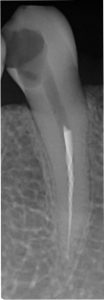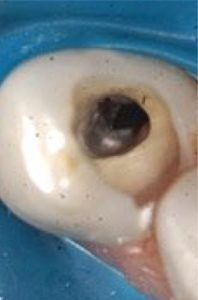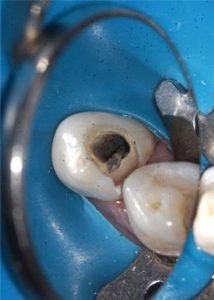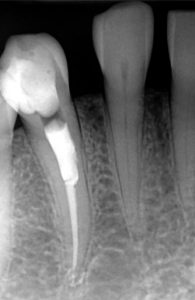A case study by Dr. Chafic Safi, Centre Endodontique St-Laurent
A 51-year-old Caucasian female patient presented herself at our clinic with the following primary complaint:
“my tooth hurts, I need to fix my root canal.”
Analysis
A clinical exam revealed a temporary restoration on her lower right canine (#43).
Percussion testing was positive. Probing and mobility was within normal limits.
A radiological exam revealed a previously accessed tooth. There was a pronounced mid-root distal dilaceration and a separated rotary file reaching the apical third of the root.
Diagnosis
The diagnosis was a previously initiated therapy and symptomatic apical periodontitis.
- Figure 1: Radiographie pré-opératoire montrant la lime séparée / Pre-operative radiograph showing the separated instrument
- Figure 2: Photo clinique montrant la séquence de l’ablation de la lime. Des pointes ultrasonores furent utilisées pour faire vibrer la lime et la sortir du canal. / Clinical picture showing the sequential retrieval of the instrument. Ultrasonic tips were used to vibrate the instrument out of the canal
Treatment
The treatment options offered to the patient were:
- A non-surgical root canal treatment with bypass or retrieval of the instrument
- An extraction
Treatment Selection
The patient opted for saving her tooth via a root canal treatment.
Potential Complications
The following potential complications were discussed with the patient:
- perforation
- separation of another instrument
- blockage/not being able to retrieve or to bypass the separated instrument.
More information
Reasons for file separations
- Cyclic fatigue: Over-use of the file
- Torsional stress: Locking and over-twisting of the file
Tips on preventing file separations:
- Pre-operative radiograph analysis: dilacerations, calcifications, …
- Adequate access opening
- Proper glide path
- Don’t force files
- Don’t overuse files
- Smooth gentle motion
Additional Images
- Figure 3: Photo clinique montrant la séquence de l’ablation de la lime. Des pointes ultrasonores furent utilisées pour faire vibrer la lime et la sortir du canal. / Clinical picture showing the sequential retrieval of the instrument. Ultrasonic tips were used to vibrate the instrument out of the canal
- Figure 4: La lime récupérée mesurant 12mm. La longueur de travail était de 25mm / The separated instrument retrieved measuring around 12mm. The working length was 25mm
- Figure 5: Radiographie finale. Le système endo-canalaire est scellé avec du “Bioceramic sealer” / Final radiograph. The root canal system was sealed using Bioceramic sealer




